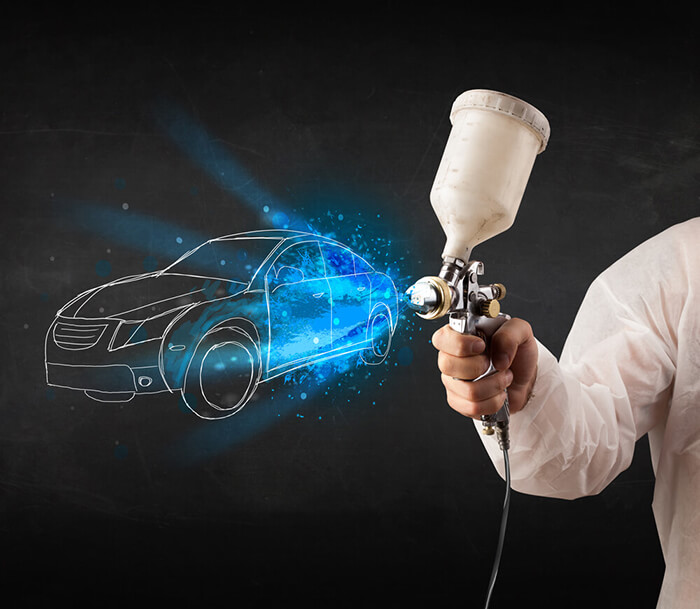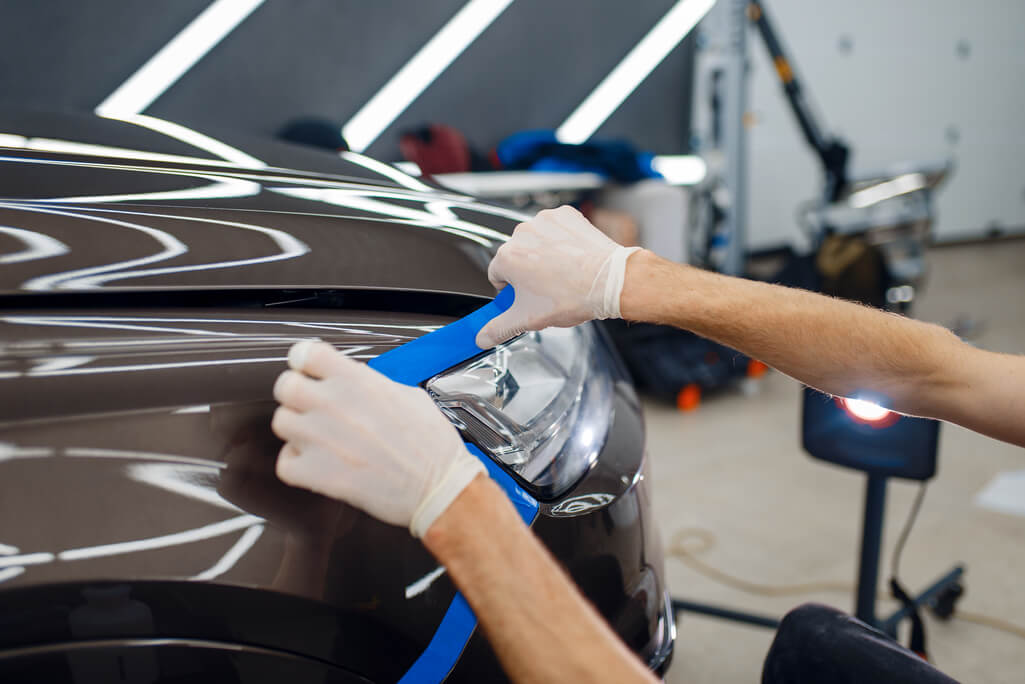
All car owners out there tend to experience the same cycle of feelings from start to finish. Think you’re one of them too? Let’s see if this resonates! Whatever the case, here’s all you need to know about car touch up paint.
You’ve just bought your car. It doesn’t even matter if it’s brand new out of the factory or pre-loved. All you know is that it’s yours, and that you’re so happy to finally have it. You’ve saved up for quite some time, set your eyes on it after reviewing many options, and now the day is here: you’ve brought it home, and it’s all yours for looking at and driving.
Looking at your brand new car is actually an experience in itself. It’s soothing for the eyes to see the smooth shine, how bright and perfect the paint looks, and how clear your own reflection in it is!
The surface of your new vehicle is simply impeccable, you can see no scratches, and the color is so vivid. How are you so lucky to have this gem parked where you can see it and take it for a ride at all times?
Yes, indeed, you are lucky. But, as time passes, this feeling of excitement starts to fade.
The paint begins to lose its glossy shine, and the surface gains some blemishes. Spots, cuts, marks of all sorts, minor scratches, and patches of sun-faded paint begin to appear. No wonder the feeling of enthusiasm starts to lose its grasp on you, and others start taking their place. Frustration, annoyance, and, perhaps, even disappointment.
Should you fully restore your car paint? Should you look into car touch up paint? These questions won’t let you be, and the answers are nowhere in sight.
Unless…
This is natural, and a more common occurrence than you may think, and that’s simply because all cars will experience some level of paint coat deterioration over time. Today, we will focus on the factors behind car scratches and swirls — the kind that can be corrected with touch up paint.
We’ll also take a closer glimpse at what you can do to restore the color of your car, fill it, and make it look great again.
We hope this article will help you find the solution that best fits your needs, so you can quickly return to being the proud car owner you once were. We also aim to give you all the information you need on car touch up paint, so you can efficiently turn things around for your car by yourself, without needing to call professional detailers for this specific service.
What Happens To Car Paint Over Time?
To answer this briefly, a lot! Plenty of negative things happen that will impact the integrity of your car’s paint. Some of them you may anticipate as a car owner, and others you may never even have considered to be such powerful contaminants.
What they leave behind is an affected paint coat, a pale comparison to what it used to be when you first got the car. It’s really a shame because what is the purpose of owning a car if you are not fully enjoying it?
Depending on how bad a certain area looks, you can resort to different solutions to fix it.
The affected area may have been severely impacted, in which case you can consider a full car paint restoration, which you can even do yourself. If the negative impact is less severe, then you can definitely choose car touch up paint.
When it comes to the culprits involved in car paint deterioration, there are plenty of factors causing it. In this article, we are going to focus on those specific factors behind car scratches and swirls — the kind that you can correct with touch up paint.
Road-Specific Contaminants
Just by taking your car out of the garage and driving it on the road, you expose it to a wide array of contaminants that are simply difficult to avoid.
We’re talking rock chips that bounce off the road and straight onto the surface of your car, leaving behind scratches that can either be lighter or deeper, depending on the speed of impact and the size of the rocks.
Then there is also road grime and dirt. Both are rough in composition and tend to settle on the car, damaging the paint itself, causing pesky micro-scratches.
Before you make it to the car wash in time, some small, yet sometimes noticeable amount of damage to the paint job has already taken place. Then the next logical step is correcting everything with car touch up paint. Thankfully, that’s not difficult at all.
Abrasive Cleaning Compounds
Few people consider the fact that certain auto cleaners out there have a less than friendly composition that can harm the paint coat of your car. Automotive paint is typically protected by a clear coat. Once this is broken through though, there’s nothing protecting the actual paint itself anymore.
There are many car care products on the market that are pretty abrasive. So, it’s highly recommended that you prioritize quality over anything else when shopping.
Improper Washing And Drying
Even if it seems improbable, improper washing and drying may cause significant damage to your car’s paint. You must pay attention to both what you wash your car with — and how you wash it.
If you don’t want to resort to car touch up paint, you should never use dishwashing liquid, hand soap, or glass cleaner on your car. These are all terribly bad for your car and will definitely take a toll on the integrity of the paint.
Be sure to also use a quality sponge and have a microfiber towel in handy.
While using the sponge, try to avoid circular motions, as this will create visible marks.
Instead, use the sponge across the length of the car following the body lines, covering the panels and hood.
When you dry the car, make sure you don’t let it simply air dry, as water spots will surely rear their ugly heads on the surface of your vehicle. Don’t just drag the drying cloth down! Instead, blot up the water with a chamois or a very soft terry cloth.
Car touch up paint will most definitely correct all these unwanted imperfections, but it’s best to always prevent rather than find ways to fix issues.
How Can You Prevent Scratches?

Of course, it’s always best to steer clear of issues before they happen instead of striving to find solutions. This is why we want to show you everything you can do to prevent scratches from appearing on the surface of your car;
1. Give Your Car a Regular And Proper Wash
As we’ve said before, improper washing and drying can lead to visible damage on your car’s paint coat over time. Try, then, quality washing products and drying your car using a very soft cloth that won’t leave marks. Otherwise, you’re bound to be looking for car touch up paint sooner than later.
2. Choose High-Quality Car Cleaning Products
The automotive industry is large and accommodating — unfortunately, that means that you can find less well-intended car care products on the market. What we mean is that some car care products have not been designed with quality in mind first.
If a certain product is popular, it doesn’t necessarily mean it’s also high-quality, so make sure to research thoroughly before purchasing.
3. Avoid Small Accidents
Scratches can also appear as a result of poor parking or driving or simply by accident.
Having said this, make sure you always park your car in a less crowded area, where there’s a smaller chance of someone brushing up against the surface of your car with either something they’re carrying or with the vehicle they’re driving. It’s scratches like these that also fall under the scrutiny of car touch up paint which, thankfully, can correct them all!
4. Polish, Wax, And Ceramic Coat Your Car
This trifecta of car care procedures is extremely efficient if you really want to go the extra mile and protect it from any harmful contaminants causing unpleasant scratches to the car paint coat. First, ensure you remove all remaining debris after washing by polishing your car. This is a kind of preparation for what comes next: waxing.
Once this is done, you can get a carnauba wax and apply it manually by using a dual-action polisher. This will certainly level up your vehicle’s shine while also adding much-needed protection.
However, if you really want to give it unbeatable protection and ensure that car touch up paint is a distant last resort, then you should give your car a nice ceramic coating session.
The great news is that with patience and dedication, you can easily do this by yourself and steer clear from marks and scratches for as long as possible.
Still, you’ll need to shop for the best possible product on the market if you want a showroom shine and unmatched protection.
We recommend Nexgen’s Ceramic Spray, designed with a higher composition of SiO2 than similar items on the market. It contains an innovative 13% compared to most other products that come with only a 1%.
At the end of it all, silicon dioxide makes all the difference in terms of protection. This is why, from our point of view, the title of best DIY ceramic coating product on the market goes to Nexgen!
This way you can definitely keep car touch up paint at bay and enjoy a car that’s free of scratches for the longest possible time.
Does Car Touch Up Paint Work?
In short? It absolutely does! And you won’t believe how you can do something so seemingly complex in such an easy manner.
Have no second thoughts about it, since touch up paint repairs, if done right, fix even the most deep and difficult of scratches. Doing it right includes the preparation stage, just as much as it does the actual paint job session itself.
Regardless of what caused the scratch on your car, with attention, dedication, and the right product at hand, you can fill even the most annoying scratches. It only makes sense that micro-scratches will quickly be a thing of the past as well after using your car touch up paint.
What’s more, if you want to save money and not throw it all in the hands of professional car detailers, you can easily apply the touch up paint by yourself, with care and thoroughness.
Continue reading and find all the tips you need regarding the application of the touch up paint, so you can benefit from the best results you can.
How Do You Touch Up Car Paint?

Now that we’ve talked about why you may need to use touch up paint on your car, we’d like to show you how you can touch up your car paint yourself. This project is not difficult at all! And, as long as you follow the steps, you should be able to get brilliant results and a blemish-free paint coat thanks to your car’s touch up paint.
Find And Order Your Desired Paint
If you want excellent results with your car touch up paint, first of all, you’ll need to color match what your car already has with what you’ve found in the shop. You’ll also be able to order all the paint accessories for the job — a brush, perhaps, if your product doesn’t already include it, plus a primer.
These are all the tools you need! Perfectly matching the colors is possible, and you can get an exact match to your factory paint.
If you’re a new customer, check this secret tip: use the paint code of your original paint, and you’ll have a color match guarantee.
Test And Find The Perfect Color Match
To figure out if you’ve found the perfect color match, you must first test it on another piece of metal. If you find your ordered color matched your factory one, then you’re good to go, and you can readily start the scratch repair process by using your car touch up paint.
Ensure The Area Is Rust-Free
It’s essential that you refrain from applying the car touch up paint until you ensure the area you want corrected is actually rust-free. Rust has a way of spreading underneath the paint, so you must eliminate all traces of it straight from the get-go. If the affected area is relatively small, you can use a 220 grit sandpaper to clear the rust.
A rust arrestor will also prevent it from wreaking havoc even further underneath the paint coat.
Ensure The Painting Conditions Are Right
Before you start the process, ensure all conditions are favorable. Having said this, you should consider painting your car in a low-humidity place that’s also far away from direct sunlight. If you respect these requirements, your car touch up paint should do wonders for the damaged area.
Selectively And Sparingly Apply The Primer
Look for the areas where the bare metal is showing, do not let any primer get on the original paint. If it does happen, make sure you wipe it off immediately. Let the primer dry for at least 20 minutes.
Apply The Paint Into a Base Coat
It’s finally time to use the color paint you’ve ordered. Apply as many thin coats as needed until you feel the damaged area begins to match the rest of the car. Just make sure this newly restored area is not any thicker than the rest of the car.
Lastly, leave to dry for at least 20 minutes and even overnight if you must.
Apply a Clear Coat
The auto factory paint coat needs to be protected, and this is done through the clear coat that’s applied over it. It will be the same for the affected area.
Simply apply the clear coat over the spot where you’ve applied the car touch up paint. You should let the first layer of clear coat dry for about 10-20 minutes and then repeat this procedure multiple times. This will ensure increased protection for your newly restored paint area.
Give It Time
To complete the process successfully, make sure you’re allowing the paint coat and clear coat to dry for a few days. Three days should be enough.
Polish And Wax
If you want to blend all your car sections into one gorgeous gloss, make sure you polish the entire vehicle and then wax it for optimum results. This way you’ll minimize any remaining visible difference between the original paint coat and the portion where you applied the car touch up paint.
These are the exact steps you need to successfully apply touch up paint by yourself and get the satisfying results you craved.
However, you may still be wondering what kind of product you should go for. What types of touch up paint are there, and which one is the best for you?
Let’s quickly see what these are below.
What Is The Best Car Touch Up Paint?
If you want ultimate success in this process, you should also know your options to make an informed decision. So which is the type of car touch up paint that best suits you?
Touch Up Paint Pens
As the name suggests, touch up paint pens are designed to cover a small damaged area and are meant for a job of finesse rather than covering large portions of affected paint.
This type of automotive touch up paint is widely used in the auto industry, and you can easily keep it in the glove compartment in case you encounter a minor scratch that needs to be addressed on the spot.
Touch Up Bottle
The touch up bottle is designed to fix larger areas of affected paint, and it usually comes with a brush attached at the top. It’s designed as a kind of kit that can offer you anything you need to get the job done on the spot, hassle-free.
Some car touch up paint bottle kits have low-quality brushes and if you happen to notice this, simply buy a better one from the art shop instead. It’s better to be safe than sorry in this case, as a paint blob is much more difficult to correct than anything else.
Spray Cans
Sometimes, neither pens nor bottles can do the required job! In this case, touch up paint spray cans are the best option you could have.
These cans can be used for both minor scratches and bigger ones. If you only have a light scratch to deal with, you can simply spray some paint in a cup and then use a brush to finish the job. If you have a bigger area to cover, use the nozzle – it will do an excellent job.
However, we do recommend that you get a can with a nozzle that can spray in a vertical fan.
Final Thoughts
Now that you know what types of car touch up paint are out there, you can easily choose the one that most fits the type of paint restoration you have on your hands.
We also hope you are now better equipped to apply the touch up paint all by yourself while also resting assured that excellent results are guaranteed. Simply follow all the instructions we’ve detailed above, and you’ll be on a sure path to getting that showroom shine you’ve been missing out on.
Touch up car paint is easy to apply, and an affordable alternative to an otherwise expensive service offered by professional detailers. So why not benefit from everything it has to offer?
If you have any questions regarding your touch up car paint journey, don’t hesitate to reach out to us! We will be happy to answer them all. And, if you enjoyed this article, you might also like:



